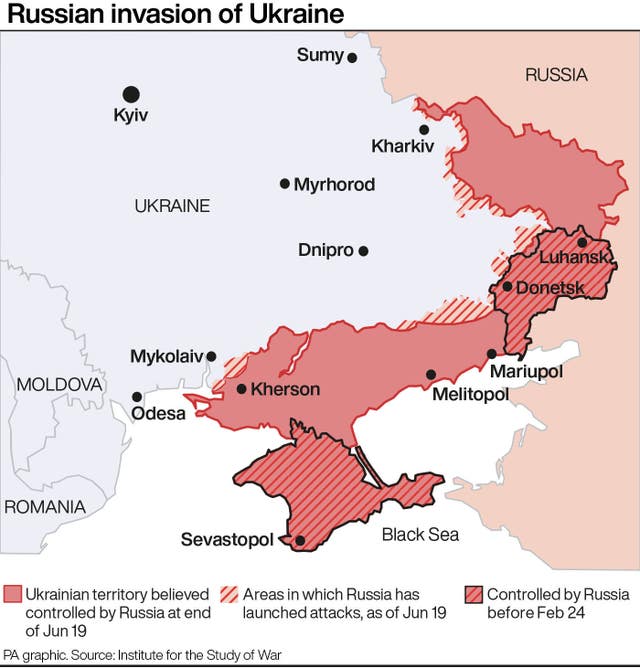Russian forces are trying to block a city in eastern Ukraine, the region’s governor said, after a relentless assault on a nearby city forced Ukrainian troops to begin withdrawing after weeks of intense fighting.
Russia also launched missile attacks on areas far from the heart of the eastern battles.
Serhiy Haidai, governor of the Luhansk region, said on Facebook that Russian forces are attempting to blockade the city of Lysychansk from the south.
The city lies next to Sievierodonetsk, which has endured relentless assaults and house-to-house fighting for weeks.

Russia’s Interfax news agency quoted a spokesman for the separatist forces, Andrei Marochko, as saying Russian troops and separatist fighters had entered Lysychansk and that fighting was taking place in the heart of the city.
There was no immediate comment on the claim from the Ukrainian side
Lysychansk and Sievierodonetsk have been the focal point of the Russian offensive aimed at capturing all of eastern Ukraine’s Donbas region and destroying the Ukrainian military defending it – the most capable and battle-hardened segment of the country’s armed forces.
The two cities and surrounding areas are the last major pockets of Ukrainian resistance in the Luhansk region – 95% of which is under Russian and local separatist forces’ control.
The Russians and separatists also control about half of the Donetsk region, the second province in the Donbas.
Russian bombardment has reduced most of Sievierodonetsk to rubble and cut its population from 100,000 to 10,000.
Some Ukrainian troops are holed up in the huge Azot chemical factory on the city’s edge, along with about 500 civilians.
A separatist representative, Ivan Filiponenko, said forces evacuated 800 civilians from the plant during the night, Interfax reported.

After Mr Haidai said on Friday that Ukrainian forces had begun retreating from Sievierodonetsk, military analyst Oleg Zhdanov said some of the troops were heading for Lysychansk.
But Russian moves to cut off Lysychansk will give those retreating troops little respite.
Some 600 miles to the west, four Russian rockets hit a “military object” in Yaroviv, Lviv regional governor Maksym Kozytskyy said.
He did not give further details of the target, but Mr Yaroviv has a sizable military base used for training fighters, including foreigners who have volunteered to fight for Ukraine. That base was hit by Russian rockets in March, killing 35 people.
The Lviv region, although far from the front lines, has been hit by other rockets during the war, destroying fuel storage areas.
About 30 Russian rockets were fired on the Zhytomyr region in central Ukraine on Saturday morning, killing one Ukrainian soldier, regional governor Vitaliy Buchenko said.
In the north, about 20 rockets were fired from Belarus into the Chernihiv region, the Ukrainian military said.
Ukraine’s air command said Russian long-range Tu-22 bombers were deployed from Belarus for the first time.

The neighbouring country hosts Russian military units and was used as a staging ground before Russia invaded Ukraine, but its own troops have not crossed the border.
Russian President Vladimir Putin met with Belarusian President Alexander Lukashenko on Saturday in St Petersburg and told him during a televised portion of the meeting that Russia would supply Belarus with the Iskander-M short-range ballistic missile system in the coming months.
Mr Putin noted that the missiles can carry nuclear as well as conventional warheads.
Russia has launched several Iskander missiles into Ukraine during the war.
A senior US defence official, speaking in Washington on condition of anonymity, on Friday called the Ukrainians’ move out of Sievierodonetsk a “tactical retrograde” to consolidate forces into positions where they can better defend themselves.
This will add to Ukraine’s effort to keep Russian forces pinned down longer in a small area, the official said.
Following a botched attempt to capture Kyiv, Ukraine’s capital, in the early stage of the invasion that started on February 24, Russian forces have shifted their focus to the Donbas, where the Ukrainian forces have fought Moscow-backed separatists since 2014.
After repeated Ukrainian requests to its Western allies for heavier weaponry to counter Russia’s edge in firepower, four medium-range American rocket launchers have arrived, with four more on the way.

The senior US defence official said on Friday that more Ukrainian forces are training outside Ukraine to use the High Mobility Artillery Rocket Systems, or HIMARS, and are expected back in their country with the weapons by mid-July.
The rockets can travel about 45 miles. Also to be sent are 18 US coastal and river patrol boats.
The official said there is no evidence Russia has been successful in intercepting any of what has been a steady flow of military aid into Ukraine from the US and other nations.
Russia has repeatedly threatened to strike, or actually claimed to have hit, such shipments.




Comments & Moderation
Readers’ comments: You are personally liable for the content of any comments you upload to this website, so please act responsibly. We do not pre-moderate or monitor readers’ comments appearing on our websites, but we do post-moderate in response to complaints we receive or otherwise when a potential problem comes to our attention. You can make a complaint by using the ‘report this post’ link . We may then apply our discretion under the user terms to amend or delete comments.
Post moderation is undertaken full-time 9am-6pm on weekdays, and on a part-time basis outwith those hours.
Read the rules hereLast Updated:
Report this comment Cancel